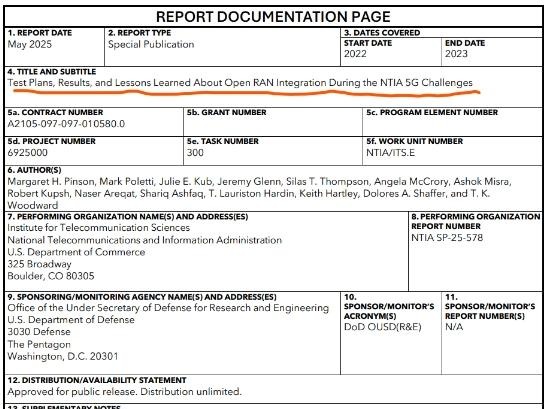U.S. Department of Commerce ORAN Test Report: Technology Breakthroughs Encounter Market Reality
This week, the National Telecommunications and Information Administration (NTIA) released the results of a two-year "Open RAN" test, showing that although Open RAN technology has passed the early stage, it will take time to reach the same maturity as traditional single-vendor solutions.
NTIA is an agency of the US Department of Commerce, part of its responsibility is to provide telecommunications policy advice to the president.
The program was announced during the Biden administration in 2022 and aims to "accelerate the adoption of open interfaces, interoperable components and multi-vendor solutions to promote the development of an open 5G ecosystem." Competition activities.
Radisys, Capgemini, Mavenir and Fujitsu are said to have participated in the 2022 challenge. Mavenir, NewEdge, Radisys, Fujitsu and GXC participated in the 2023 event.
Technological breakthroughs and the gap between reality
NTIA's test report (report link at the end of the article) outlines the current status of open RAN with a set of data:
Four of the vendors have successfully achieved cross-vendor equipment networking - completing the interconnection of O-CU, O-DU and O-RU from different vendors through the Xn interface, and realizing call switching on the N2/Xn interface.
This shows that the open RAN interface technology has made substantial breakthroughs, but the report also points out that compared with the single-vendor solution, there is still a significant gap in the software maturity of open RAN, especially in the upgrade of AI/ML algorithms required for network optimization.
A total of nearly 20 entities' products participated in the test, and NTIA did not disclose the list of companies that passed the test. This practice of "only giving results but not lists" has caused speculation in the industry about the integrity of the test.

Industrial competition under policy pushers
Behind this technological competition is the deep projection of the Sino-US technological competition. The "Open RAN Plan" launched during the Trump administration is essentially a strategic extension of the "de-Sinicization" of communication networks.
NTIA under the US Department of Commerce supports local companies through a $1.5 billion funding plan, and the Department of Defense has included open RAN in the military procurement list.
However, the reality is contrary to expectations:
Mavenir and Parallel Wireless, American manufacturers trying to replace Huawei and ZTE, are in financial difficulties; AT&T, which claims to fully embrace open RAN, still relies heavily on Ericsson equipment for its network.
The most ironic thing is that Dish Network, which is regarded as a benchmark for "de-Sinicization", has an open RAN network consisting of 24,000 base stations, and the core equipment mainly comes from Samsung - this Korean manufacturer is neither a traditional equipment manufacturer nor a local American company.
The only good thing is that Airspan in the United States seems to have become a revitalized open RAN supplier, hoping to occupy a larger market share.
Cooperation dilemma and standard dispute
The fatal injury of open RAN comes more from the difficulty of industry (ecosystem) collaboration. The three major obstacles revealed by NTIA testing are very representative:
Funding black hole: lack of special funds to fix cross-vendor software compatibility issues; trust deficit: companies are reluctant to share core codes, resulting in difficulties in interface docking; system rigidity: some subsystems are designed to be "specific to specific customers", losing their open nature. "When problems arise, manufacturers first blame each other instead of collaborating to solve them," a representative of a company participating in the test revealed. This situation of each doing its own thing is an ironic contrast to the "multi-supplier ecosystem" expected by policymakers.
What's more difficult is that the Open RAN standards that the United States is trying to promote are encountering international resistance - European operators generally require the retention of the technical routes of traditional equipment manufacturers, while Asian manufacturers are stepping up to build their own ecosystem.
Despite the many contradictions, NTIA still paints an optimistic prospect for open RAN: by establishing a global unified testing and certification system, it will promote technology iteration and industry collaboration.
However, "open RAN should not be a tool for technological nationalism," communications industry observers pointed out. When policy goals conflict with technological laws, the United States is facing a difficult choice:
Should it continue to push the "non-China solution" and cause ecological fragmentation, or should it respect technological development and market laws to build a truly open ecosystem?